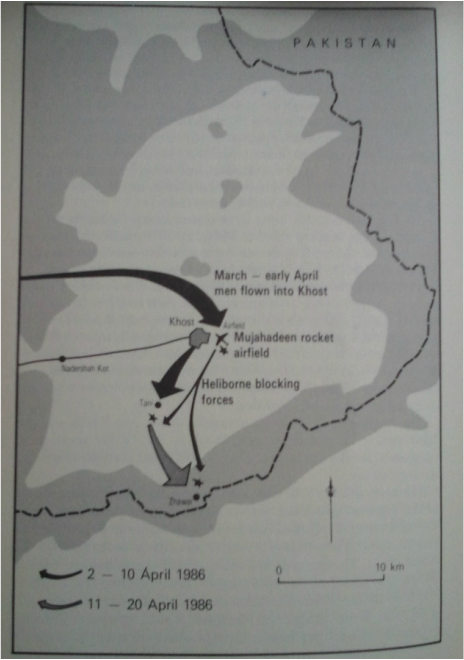The War in 1986
Zhawar
Having already failed to take Zhawar, a Mujahideen logistic and supply base, in 1985, the Democratic Republic of Afghanistan (DRA) was encouraged to attempt another take-over by the Soviets early 1986. During March of 1986, the DRA amassed a force which would only be slightly supported by the Soviet army. During the first week of April, the 12000 man army, consisting of only 2200 Soviet troops, set out from Khost, heading to Tani, defeating several small bands of guerrillas on the way. Pushing out from Tani for Zhawar on April 11, the mixed army encountered a much greater oppositional force. After nearly ten days of fighting, the DRA forces had made it to the outer defenses of Zhawar. During the next several days of gunfire and Soviet airstrikes, Jallaladin Haqqani, the commander at Zhawar, was injured, being immediately transported into Pakistan. Amidst all the confusion, many Mujahideen fighters believed Haqqani to be killed, causing them to retreat into the surrounding mountains. The DRA army looted part of the base and left, Colonel Kutsenko and his group staying behind to destroy the caves. Knowing they couldn't completely demolish the caves in the allotted time, the group took out as much as they could and set mines, heading back to Khost as ordered. After a mere five hours the Mujahideen again had control of their base, and a fair number of supplies that remained.
U.S. Involvement
After a long period of consideration, the United States decided to start supplying the Mujahideen with Stinger missiles. Before this, the Mujahideen had no good way of defending themselves from Soviet airships, often being left vulnerable to attack. Not long before the U.S. started supplying Stingers, Great Britain had begun giving them Blowpipes, a much less effective missile than the Stinger. By October of 1986, the Mujahideen had around 200 Stingers. After the introduction of this weapon, the Soviets had to rethink their strategy, no longer being able to Use as many Air tactics.
Limited Soviet Withdrawal
In early 1986, Mikhail Gorbachev began planning the initial phase of Soviet withdrawal. The battle at Zhawar was essential in showing what the DRA could do mostly unaided, a test to see how well the DRA could do when the Soviet's withdrew. On July 28, Gorbachev announced to the world his partial removal of his forces from Afghanistan. Only around 7000 of the 118000 man force were withdrawn, but it was a start.
Karmal's Resignation
In early 1986, Babrak Karmal's, the DRA president, position was failing. Government papers started reporting on his bad health (he was suffering from respiratory disorders). Even worse than his health was his relationship with Moscow. Gorbachev didn't see him as a strong enough leader, and hinted at a replacement. Several months later Karmal is forced into resignation, Mohammad Najibullah taking over. Najibullah had much stronger political ties, and supported the Soviets whole-heartedly.
Westermann, Edward B. "The Limits of Soviet Airpower: The Failure of Military Coercion in Afghanistan, 1979-89." University of New Brunswick Libraries. Fall 1999. Web. 25 Sept. 2011. <http://www.lib.unb.ca/Texts/JCS/fall99/WESTERMA.htm>.
Urban, Mark. War in Afghanistan. New York: St. Martin's, 1988. Print.
Grau, Lester W., and Ali Ahmad Jalali. "THE CAMPAIGN FOR THE CAVES: THE BATTLES FOR ZHAWAR IN THE SOVIET-AFGHAN WAR." Foreign Military Studies Office. Sept. 2001. Web. 25 Sept. 2011. <http://fmso.leavenworth.army.mil/documents/zhawar/zhawar.htm>.

